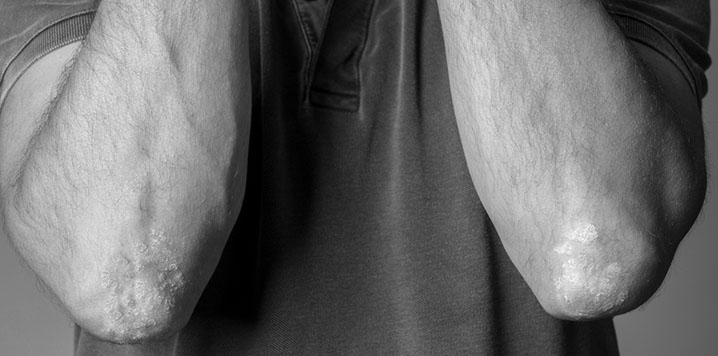Home » General Dermatology » Eczema Treatments
Find relief for your dry skin and eczema at DermaBlue.

Atopic dermatitis (eczema) is a chronic, itchy inflammatory condition of the skin that is often associated with asthma or hay fever. The cause of atopic dermatitis is an inability of the skin to properly retain water. It tends to run in families and is made worse by irritating clothes or chemicals, change in temperature or humidity, stress, and skin infections. Atopic dermatitis usually starts in early childhood. Most people grow out of it, but adults can continue to have atopic dermatitis either over their whole body, or more commonly on their hands.
Atopic dermatitis (eczema) symptoms and signs vary widely from person to person and include:
Atopic dermatitis most often begins before age 5 and may persist into adolescence and adulthood. For some people, eczema symptoms flare periodically and then clears up for a time, even for several years.

Most people with atopic dermatitis also have Staphylococcus aureus bacteria on their skin. The staph bacteria multiply rapidly when the skin barrier is broken and fluid is present on the skin. This in turn may worsen eczema symptoms, particularly in young children.
Other factors:
Atopic dermatitis is related to allergies. But eliminating allergens is rarely helpful in clearing the condition. Occasionally, items that trap dust — such as feather pillows, down comforters, mattresses, carpeting and drapes — can worsen the condition
Atopic Dermatitis treatment is aimed at keeping the skin moisturized and reducing the redness and itching.
Avoid Irritants
harsh soap, wool clothes, and chemicals. Washing should be done with a mild soap (Dove, Oil of Olay, and Cetaphil). For routine bathing, soap should be limited to the face, armpits, and groin. Washing other body parts with soap just removes the natural oils and dries out the skin, making atopic dermatitis worse. Body odor comes from sebum in the groin and armpits, so limiting soap use to these areas will not make you smell. You should try to avoid lanolin products. People with atopic dermatitis are frequently allergic to lanolin (wool oil). Lanolin is found in many moisturizers and skin care products.
Bathing habits
Hot water and prolonged exposure to water and soap will remove the natural oils from the skin and dry out the skin further. During a bath water is trapped in the top layers of skin which is good, but will evaporate within 2 or 3 minutes of coming out of the bath. Daily bathing is acceptable as long as you keep the temperature warm (not hot), limit the amount of time spent in the water, towel dry and apply a moisturizer immediately after coming out of the bath or shower.
Moisturizers
This Atopic Dermatitis treatment should be used liberally and frequently (2 to 3 times per day). They should be applied immediately after bathing to “seal in” the water (within 2 to 3 minutes). Keeping the skin moist helps to prevent the dryness and prevent flares of atopic dermatitis. As a general rule, the greasier they are, the better they work. Examples of good moisturizers are Cetaphil, Eucerin, SBR-Lipocream, CeraVe, and plain Vaseline petroleum jelly. Lubriderm is a good lighter moisturizer.
Steroids
Topical steroid creams and ointments are used cautiously only on red, itchy areas as prescribed by your doctor. They should not be used in place of a moisturizer. They can be used safely if you carefully follow your doctor’s instructions, but can have side effects such as thinning of the skin, cause acne, and cause little blood vessels to become larger and more prominent. Use of very large amounts of topical steroids can even cause high blood pressure, thinning of the bones, and steroid dependence (adrenal suppression).
Protopic/Elidel
This is a new, non-steroid immunosuppressive agent. It often times works better than topical steroids and has none of the side effects of topical steroids. This Atopic Dermatitis treatment can sting when it is initially applied and is much more expensive than topical steroids. These take longer to take effect than topical steroids. They are often used for long term maintenance treatment with topical steroids used for flare ups.
Antihistamines – Benadryl or prescription antihistamines can reduce the itching, but usually cause some drowsiness. They are most commonly used at bedtime. Prescription strength non-sedating antihistamines such as Claritin, Zyrtec, and Allegra are other atopic dermatitis treatments and can be helpful for itching during the day.
Moisturizing Baths
Aveeno (oatmeal) or Cutar (tar) bathes are sometimes recommended. Soak for 15 minutes, rinse off, towel dry, and immediately apply a moisturizer.
Antibiotics
One of the main functions of the skin is to keep out bacteria. When a person has a bad case of atopic dermatitis (or other types of rashes too) then the body is not able to suppress bacterial growth at that site and they can be secondarily infected. Staphylococcus Aureus is the most common bacteria found and is usually treated with dicloxicillin, cephalexin, or omnicef – but other antibiotics can also be effective. If you have any questions or problems, please contact your doctor or nurse at our clinic.
Asheville Location
1998 Hendersonville Rd, Unit 53
Asheville, NC 28803
828-585-5489
Hendersonville Location
120 South Grove Street
Hendersonville, NC 28792
828-685-2917
© 2024 DermaBlue. All rights reserved. | Privacy Policy | HIPAA Compliance
NEW PATIENTS GET $50 OFF ANY COSMETIC TREATMENT
Take the first step towards your aesthetic goals with our complimentary 30-minute consultation. Simply fill out the form below and a patient care coordinator will be in touch shortly to help you schedule your consultation.

This website uses cookies to improve user experience. By using our website you consent to all cookies in accordance with our Cookie Policy. We do not sell your data. Read more